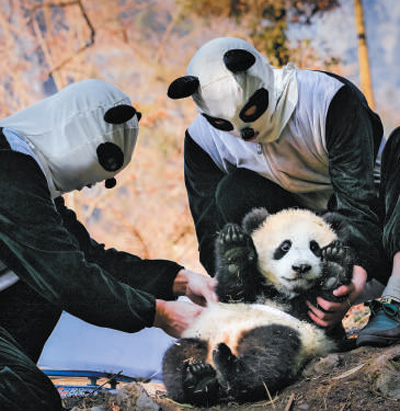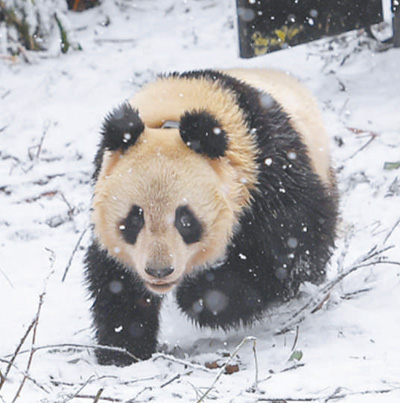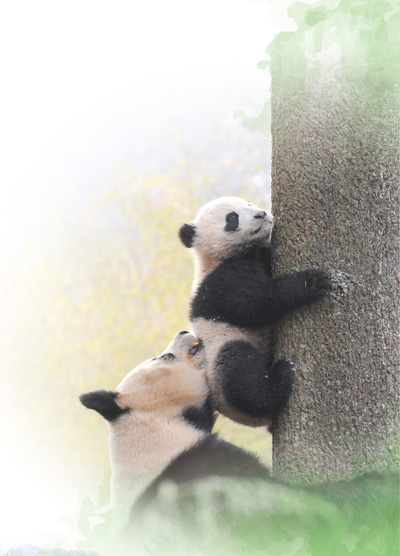
The Giant Panda National Park has beautiful scenery. The picture shows Liziping area. Photo courtesy of National Forestry and Grassland Administration

The researchers gave the panda cubs a health check-up. He Shengshan photo

The giant panda Qin Xin was released into the wild. He Haiyang photo

Mother panda teaches her cubs to climb trees. Photo by Xue Yubin

Researchers use radio equipment to track and monitor the dynamics of giant pandas. Photo courtesy of China Giant Panda Protection Research Center
Driving from Dujiangyan City, Sichuan Province, along the winding Panshan Highway all the way to the west, after traveling for more than an hour, I arrived at Walnut Ping Base of China Giant Panda Protection and Research Center (hereinafter referred to as "Panda Center"). The climate here is cool, rainy and humid, and it is located in the natural living environment of giant pandas, which is very suitable for wild training of captive giant pandas.
The wild release of captive giant pandas is the key technology pioneered by Panda Center, which is mainly divided into wild training, release and monitoring stages. Over the years, generations of researchers have devoted a lot of efforts to establish a perfect technical system for panda wild training and release monitoring, which has achieved good results in practice.
Why should the giant panda be released from the wild, and what is the significance of this for the protection of the giant panda population? What "training courses" do giant pandas have to take from captivity to release? Recently, the reporter conducted a field visit.
Wild release is an important means to rejuvenate and rebuild the wild panda population.
The mountains are green and the streams are trickling. In the wild training area of Hetaoping base, except for a path trodden by the staff up and down the mountain, there are almost no traces of human activities, and the original ecology is preserved. In order not to disturb the silence, the reporter turned the phone to mute and walked in here softly.
In the dense jungle, the giant panda "Bos" is sleeping soundly with her cubs. Not far away, breeders dressed in "panda suits" are using this time to clean the pens and replenish fresh bamboo.
"In order to cover up the smell of human beings, ‘ Panda suit ’ It is sprayed with extracts of panda feces and urine. " He Shengshan, director of the animal management department for field research at Hetaoping Base, told the reporter that unlike the closeness and dependence of captive giant pandas on the breeders, the breeders of wild training should always remain "invisible".
Wild release is an important means to rejuvenate and rebuild the wild population of giant pandas, which is of great significance to the protection of giant pandas.
In recent years, China has vigorously implemented natural forest protection, wildlife protection projects and the construction of giant panda national park to protect giant pandas and their habitats, with remarkable results. The fourth national survey of giant pandas shows that the population of wild giant pandas has increased from 1,114 in 1970s and 1980s to 1,864, which are distributed in six mountain systems, including Qinling, Minshan, Qionglai, Daxiangling, Xiaoxiangling and Liangshan.
However, physical and geographical obstacles isolate these wild giant pandas in six mountain systems, and human activities divide these six habitat populations into small local populations that cannot communicate with each other. "The fragmentation of habitat leads to the failure of gene communication between isolated populations, which reduces the genetic diversity of local small populations and accelerates the disappearance of endangered small populations." Wu Daifu, director of Hetaoping Base, said.
To save a species, we must protect the integrity and stability of its community and the genetic diversity within the species. "At present, the main measures taken to protect giant pandas in China are in-situ protection and ex situ protection." Wu Daifu introduced that the connection point of the two methods is to release the captive giant pandas into the endangered small population in the wild after wild training, so as to improve their genetic diversity, reduce the risk of extinction and realize the rejuvenation of the wild giant panda population.
With the worldwide breeding problems, such as the difficulty of mating and conception, and the difficulty of raising young and surviving, the artificial breeding of giant pandas has achieved fruitful results, and the captive giant panda population has achieved self-maintenance. In 2003, the Panda Center started the wild training and release of captive giant pandas.
In April 2006, the male subadult giant panda "Xiangxiang" was released into the wild after independent wild training. However, in less than a year, the staff found its body in the snow. After analysis and judgment, "Xiangxiang" fell from a height and was seriously injured and died in a fight with wild giant pandas for territory and food.
The Panda Center concluded that Xiangxiang’s wild failure case may be due to the lack of suitable learning objects, which led to the lack of wild survival ability of Xiangxiang. Perhaps it is that the population of the released land is saturated and Xiangxiang lacks enough living space; Adult male giant pandas in the wild compete fiercely for territory and spouses, and "Xiangxiang" may be inexperienced in fighting and can’t stand it.
Sum up experience and make persistent efforts. In 2010, with the steady growth of the captive giant panda population, the Panda Center launched the second phase of the captive giant panda wild training project, and put forward a new method of wild training for the first time.
Help giant panda cubs learn wild survival skills from birth.
"At 1: 16 a.m., the baby barks, and the mother lies on her side to protect the baby." "At 4: 53 a.m., the mother sleeps in the posture to protect the baby." "At 8 a.m., the mother eats 9 bamboos and drinks water twice in the morning. The baby cries loudly and defecates once, and there is nothing abnormal "… … In the monitoring room of Hetaoping base, the daily dynamics of the giant panda Huihui and its newborn cubs are recorded in detail in the keeper’s work log.
At present, there are four giant panda cubs in the Hetaoping base in the first stage of wild training: Zhichunzai and Boszai, who are over one year old, and two newborn cubs. "The newborn giant panda cubs are not fully developed in all aspects. We should always pay attention to video surveillance all day, and take timely measures in case of abnormal situation." The breeder Zhang Dalei said.
According to the growth and behavioral development characteristics of giant pandas, the wild training is divided into two stages. From birth to 1 year old, in a small training circle of about 2,000 square meters, the cubs eat breast milk; About 1 year old to 200,000 before release — In the large-scale training circle of 300,000 square meters, the young gradually learned to eat bamboo independently. The large-scale training circle is selected in the wild habitat environment of giant pandas, where there are tall trees, dense bamboo forests and complex terrain, which are in a completely natural state.
On the basis of long-term practice and research, the Panda Center creatively implemented the training of "mother animals with young". "From birth, the cubs live with the mother beast and gradually learn survival skills such as foraging in nature, finding water sources and avoiding natural enemies. In the past, breeders couldn’t teach pandas to climb trees for a few days. Now the mother panda arches her baby into the tree with her mouth, and the baby panda learns to climb trees twice. " He Shengshan said that giant pandas can only be released to nature after completing a series of training and being evaluated by experts. "At this time, two or three-year-old giant pandas are in the post-weaning and pre-adult stages, and it is easier to integrate into the wild giant panda population as sub-adults."
The choice of females is very particular. "It is best for the mother animal to be a born giant panda with wild life experience, or an individual with strong parenting ability." He Shengshan said that at the same time, the female animal’s body must be kept in a healthy state, and factors such as age and genetic background should be considered.
In order to avoid the "imprinting behavior" of giant panda cubs, it is necessary to minimize the influence of human activities. "Every time the mother panda is fed with food, the breeder will wear ‘ Panda suit ’ To avoid the dependence of young children on humans. " Zhang Dalei said that pandas should avoid rather than approach actively as soon as they perceive human beings, so that they can return to the jungle smoothly.
In addition to feeding food and cleaning pens, the breeder is also responsible for observing and recording the growth and behavior of giant pandas, such as the first walking time, the first climbing time and the first eating of bamboo. Since 2012, Zhang Dalei has raised seven giant pandas for wild training. "Although the work is very hard and tiring, as long as they return to a healthy life in the wild, I feel very fulfilled."
Accompanied by giant pandas all the year round, this job is enviable, but also hides little-known risks and challenges.
In summer, mudslides often occur in the mountains, and the wilderness training circle is often tested. "The mudslide that occurred on August 20, 2019 was less than 100 meters away from the cabin where we were resting. The situation at that time was very thrilling." He Shengshan still has a lingering fear. It is also common to meet wild animals in the wild. "Wild boars, snakes, etc. are often encountered in the mountains. Only by accumulating rich experience and making full preparations can we escape the dangers again and again." He Shengshan said. Now, he and his colleagues always make preventive plans in advance. Every time they go up the mountain, they will bring enough materials and carry satellite phones with them to ensure smooth communication.
Wei Hua, a researcher, almost lost his life when he was training giant pandas in the wild. In December 2016, the cub "Baxi" who was trained in Tiantai Mountain was close to the age of being released, but no "Baxi" was found for two consecutive days. Wei Hua and his colleagues were very worried and entered the training circle to search. I didn’t expect to be attacked by the panda mother "Ximei" who was eager to protect the cub and was seriously injured. Even so, Wei Hua still thinks: "‘ Ximei ’ Bite me, indicating that it is wild and maternal, which is exactly what we are pursuing when we are released into the wild. "
Orderly release giant pandas to improve the genetic diversity of tiny populations.
How to determine the return of giant pandas to their habitat after wild training?
Hao Xie, a senior engineer in the investigation and monitoring department of Panda Center, said that the researchers will comprehensively consider various factors such as suitable habitat quality, area, biomass of staple bamboo, genetic background of released giant pandas, and so on, and determine the release site. In 2018, the giant panda "Qinxin" and "Little Walnut" were released to the Longxi Hongkou National Nature Reserve in Dujiangyan City after wild training and scientific evaluation.
How to monitor the living condition of the released giant panda?
Hao Xie introduced that giant pandas will be put on an electronic collar that can be tracked and monitored when they are released, and their trajectory, health status and other information will be tracked through satellite signals. "However, the collar will fall off in about one and a half years, and it is impossible to track and monitor for a long time. More data must be collected by means of infrared cameras and fecal sampling."
"Where is the giant panda, we will follow it." Hao Xie said that the monitoring team members searched for giant panda feces in the mountains and forests, recorded relevant detailed information, and analyzed the sex, age, population and kinship of giant pandas by extracting DNA. "In the mountains and valleys, I often walk for more than half a month, and I will rest where I catch up at night. Sometimes food supplies can’t keep up, and you have to go hungry. "
In November 2021, the staff of Dujiangyan State-owned Forest Farm photographed the wild giant panda through an infrared camera during field monitoring, which was suspected to be a giant panda released in 2018. The team of experts went to the site for an inquest and collected fecal samples for further testing. Through the DNA extracted from it, it is determined that this five-year-old female giant panda is the giant panda "Little Walnut" released in 2018.
Zhang Mingchun, deputy director of the field ecological research office of Panda Center, was very excited when he saw the image of "Little Walnut". "This giant panda has a round figure, a normal mental state and a good living condition in the wild. When the result of DNA identification proves that it is indeed ‘ Small walnut ’ After that, the wild training team was very excited, which shows that ‘ Small walnut ’ More than two years of wild training is successful. I hope it can thrive in the wild, and I hope it will find the right husband, breed offspring and bring us more surprises! "
Up to now, the Panda Center has released 11 pandas for captive breeding, and 9 pandas have survived, of which 7 have been successfully integrated into the wild population of Xiaoxiangling Mountain and 2 have been successfully integrated into the wild population of Minshan Mountain. Among the released giant pandas, 1 male, 4 females and 5 females have reached the age of 6, and they are in the prime stage of reproduction. "Only by releasing giant pandas into the wild population and breeding offspring can we achieve the goal of expanding the wild population. However, it takes patience and time to find clear evidence that giant pandas have offspring. " Wu Daifu said.
At present, China is building an integrated monitoring system for national parks. "We take this opportunity to add cameras, infrared cameras and other monitoring equipment in the area where giant pandas are released from the wild, so as to enhance the monitoring capability in large space." Yang Jian, director of the investigation and monitoring department of the Panda Center, said that at the same time, the research and development of the collar should be strengthened, and efforts should be made to improve the service life of the battery, improve the positioning accuracy and realize the real-time transmission of the recording, so as to grasp more information about the wild survival of giant pandas.
"We will evaluate the genetic contribution through the dynamic monitoring of the population." Yang Jian said that through technologies such as "cat face recognition" and DNA individual recognition, dynamic monitoring was carried out from the aspects of giant panda kinship, age structure and genetic level, and a database of regional population number, structure and geographical distribution was established to verify whether released individuals bred offspring.
Wu Daifu said that within the scope of the Giant Panda National Park, from the aspects of genetic diversity, population dynamics, community characteristics and human interference, the limited factors of rejuvenation of local endangered small populations will be analyzed, scientific planning will be made, and giant pandas will be released in an orderly manner to improve the genetic diversity of small populations. At the same time, through the release in the ecological corridor, the genetic connectivity between populations is enhanced, which provides key support for the rejuvenation of the giant panda population in the wild.
At present, the giant panda wilderness training echelon has been established, and in the future, qualified individuals will be released into the wild every year, and efforts will be made to rejuvenate the small panda population. "We will speed up the innovation, popularization and application of key technologies such as wild panda training, release and monitoring, and strive to release 3 to 6 giant pandas every year, and increase the protection of endangered small populations of wild giant pandas through introduction, and gradually establish a wild giant panda genetic germplasm resource bank to realize two-way gene exchange between captive populations and wild populations." Wu Daifu said.
关于作者